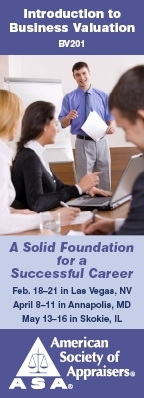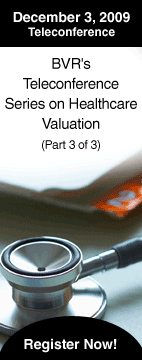
| 2010 BVMegatrends: bifurcation but not unification It’s been nearly 30 years since the book Megatrends was a megahit, identifying speed and networking as the major drivers of competitive markets (think FedEx and Facebook). With this concept in mind, the most recent ASA E-Letter (Nov. 4, 2009) from Bill Quackenbush identifies four “BVMegatrends” for our maturing profession:
What BVMegatrends do you see? Choose from the four above or add your own by clicking on this quick (two-minute) online survey. We’ll combine the results with the comments sent to Quackenbush for full coverage of BV’s bright future. Stay tuned… Outsourcing trend—as many problems as potential? Responding to the item in last week’s BVWire™ on outsourcing “entry-level”valuations, Karan Gupta clarifies what his firm (KP Synergies, Delhi, IN) delivers: “Our services offer support to BV and CPA firms in the United States who may be short-staffed but are looking for an economical alternative to hiring entry-level professionals,” he says. His analysts prepare a customized model with all the requisite data (historical financials, guideline companies, risk-free rates, etc.) in Excel/Word formats, to which the client adds any changes or revised assumptions (projections, discount rates, and multiples). “The process is similar to having an in-house analyst prepare the model and then a senior professional review it and come to a conclusion of value,” Gupta says. His firm does not work with or market to end-users; recent projects include valuing trust deed/notes in an IRS dispute and complex 409A valuations for early-stage companies. A Silicon Valley firm still sees problems. “We have seen firsthand the trend of companies wanting valuation reports for very low fees and a move by some of our competitors to outsource part or all of the work,” writes Jim Timmins, managing director Teknos Associates (Palo Alto, CA.), in response to the same BVWire item. “We see several problems.”
“Finally, we agree with John Borrowman that valuation is a business of judgment, and judgment cannot be outsourced,” Timmins says. “Although many in Silicon Valley focus only on price, we have found that by carefully explaining the legal requirements and the downstream risks to company executives, VC investors, legal, accounting, and other service providers, we create a better understanding of the importance of doing valuation work right the first time, and this has reduced the emphasis on price alone.” Three resources for default risk spread premiums “Where do we obtain the default risk spread premiums?” asked an interested listener during last week’s BVR teleconference with Jim Alerding, James Ewart, and Bob Shortle on “Companies in Distress: Valuing the Impaired and Currently Unprofitable.” The presenters provided two quick, easy, inexpensive sources: First, check out Professor Aswath Damodaran’s website—e.g., the page listing Country Default Spreads and Risk Premiums (last updated Jan. 2009). Second, Morningstar regularly posts risk ratings and premiums at its website. BVR has just posted the article, “A Timely New Study of Bankruptcy Prediction Models from Morningstar,” by Morningstar’s James Harrington and the Oct. 2009 BVUpdate™ as a third free valuation resource. Click here to download the article and more (sort the page by date and this latest download should come up first). Where are the data on restructuring costs? Unfortunately, these sources are not so easy to come by. “These costs can vary a great deal,” says Shortle. He suggests calling bankruptcy attorneys in your area to ask their experience. The company’s loan documents should identify covenant waivers and forbearance costs. “The key is to indentify all parties to the bankruptcy proceedings, and all costs that the company would not have incurred if not distressed.” For the complete teleconference, including, e-transcript, audio CD, and ancillary reading materials, click here. Applying the transaction databases in today’s economy takes time and judgment—and a newly updated Guide Hot off the presses: The Comprehensive Guide to the Use and Application of the Transaction Databases, by Nancy Fannon and Heidi Walker, 2d edition has just arrived. This new, expanded version provides an updated FAQ for each of the databases (Pratt’s Stats®, BIZCOMPS®, etc.) plus the complete transcript and presentation slides from Fannon’s most recent BVR teleconference on the topic. “Heidi and I are so thrilled with this second release of the guide to the transaction databases, particularly as the use of the market approach has come under increased scrutiny, making proper use of transaction data more important than ever before,” Fannon says, in a recent interview with BVR. The market approach is still one of the cornerstones of a complete opinion of value, under any standard of value or professional BV standard, even if transaction databases are sometimes maligned for the lack of uniformity among the data, and so forth. “In fact, this all is true,” Fannon says. The data reflect the lack of uniform behaviors among buyers and sellers in the marketplace. “We can’t say ‘hey all you buyers out there, can you please all act the same way so it’s easier for us business appraisers?’” So let’s think about what the databases really provide, Fannon adds. “They alert us to a transaction that has occurred, and the information available about it.” Valuators still have to analyze and interpret the data, get more information about a particular transaction or reject it. That takes time, Fannon says, and requires “a lot more work than just downloading an SIC code, taking a mean or median and applying it to your subject company’s revenue or some level of earnings—but when done with deliberation and thoughtful application, it can provide some of the most powerful evidence of value. We hope our new Guide helps you do just that.” To hear the complete podcast/interview and to order the Guide, click here. New updates to the Business Reference Guide, too We also just added new data to the Business Reference Guide Online Database, published by Business Brokerage Press: Over half (58%) of the records have been updated since the last version (August 2009), and over three-quarters have been updated (76%) since January 2009. These new records are now available in the online version. With up-to-date rules of thumb and pricing information for 500 types of businesses, the BRG is a vital reference tool for anyone involved in the transfer of a private enterprise. “I think it is a must in every library,” said Jim Andersen ASA, ABV, CFF, MBA, during BVR’s Valuing Dental Practices Teleconference (May 14, 2009). To view a sample and to order, click here. Rob Slee will next present his new private cost of capital survey (the lead story in last week’s ‘Wire) at the Massachusetts chapter of NACVA on December 9th. Contact nacva_machapter@dejazzd.com for more information and to register, says Edward Giardina, (Braver PC/Braver Valuation Services), program director of the MA chapter. To download the latest private cost of capital survey, developed by Slee and academic partner Pepperdine University, click here. (Thanks to Pepperdine University’s John K. Paglia, Ph.D., CFA, CPA/ABV, ASA, Assoc. Prof. of Finance and Senior Researcher, Pepperdine Private Capital Markets Project, Graziadio School of Business and Management, for the link.) Convergence confirmed for 2011 At their joint meeting last week, the International Accounting Standards Board (IASB) and the Financial Accounting Standards Board (FASB) reaffirmed their commitment to improve International Financial Reporting Standards (IFRS) and U.S. generally accepted accounting principles (U.S. GAAP), and to bring about their convergence, according to a new release. The Boards also agreed to intensify their efforts to complete the major joint projects described in their 2006 Memorandum of Understanding (MOU), as updated in 2008. (See “Ready, Set, Converge” in BVWire#72-2.) Last chance for today’s free webinar on DLOM There’s still time to sign up for BVR’s free webinar, Looking at the New Data in The FMV Restricted Stock Study™ and How to Use It, featuring Lance Hall, President of FMV Opinions and taking place today, Wednesday, November 11th at 1pm ET. During this sixty-minute web-workshop, Hall will review the impact of the newest updates to The FMV Restricted Stock Study™ and how to use the data, with special focus on adjusting discounts for lack of marketability (DLOM) during periods of volatility. “Discounts over 50% are okay,” according to Hall, who will also take participants through a detailed case study and how to connect DLOM from restricted stock studies to the volatility index (VIX). One CPE credit will be available; register here.
To ensure this email is delivered to your inbox, Copyright © 2009 by Business Valuation Resources, LLC
|
|
|



